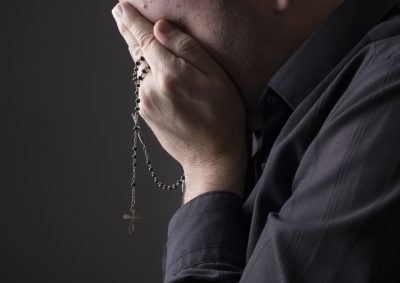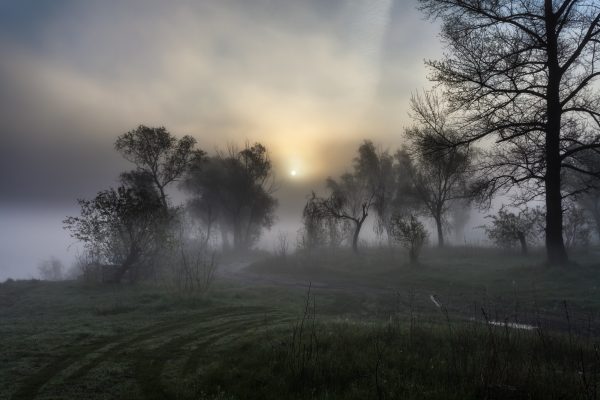 St. John of the Cross was a spiritual genius, an exacting theologian, a compassionate and wise spiritual director and a superb poet. His best known works include The Ascent of Mount Carmel, The Dark Night of the Soul, Spiritual Canticle and The Living Flame of Love. They are all commentaries on his 3 greatest poems: Spiritual Canticle (Cantico Espiritual), Dark Night (En Una Noche Oscura), and Living Flame of Love (Llama De Amor Viva). Dark Night of the Soul is a continuation of the Ascent. John co-founded (with St. Teresa of Avila) the Discalced Carmelite religious order in 16th century Spain, and even though he was sometimes persecuted by religious authorities, he was declared a Doctor of the Church by Pius XI in 1926.
St. John of the Cross was a spiritual genius, an exacting theologian, a compassionate and wise spiritual director and a superb poet. His best known works include The Ascent of Mount Carmel, The Dark Night of the Soul, Spiritual Canticle and The Living Flame of Love. They are all commentaries on his 3 greatest poems: Spiritual Canticle (Cantico Espiritual), Dark Night (En Una Noche Oscura), and Living Flame of Love (Llama De Amor Viva). Dark Night of the Soul is a continuation of the Ascent. John co-founded (with St. Teresa of Avila) the Discalced Carmelite religious order in 16th century Spain, and even though he was sometimes persecuted by religious authorities, he was declared a Doctor of the Church by Pius XI in 1926.
In addition to his major works, many letters to spiritual directees, poems and short spiritual maxims survive. When one thinks of the contemplative journey within the First Person, St. John’s poetry leaps to mind. Here are the first few stanzas of The Dark Night poem:
One dark night,
fired with love’s urgent longings
– ah, the sheer grace! –
I went out unseen,
my house being now all stilled.
In darkness, and secure,
by the secret ladder, disguised,
– ah, the sheer grace! –
in darkness and concealment,
my house being now all stilled.
On that glad night
in secret, for no one saw me,
nor did I look at anything
with no other light or guide
than the one that burned in my heart.
This guided me
more surely than the light of noon
. . . .I abandoned and forgot myself,
Laying my face on my Beloved;
All things ceased; I went out from myself,
Leaving my cares
Forgotten among the lilies1
Notice how St. John continues the ancient contemplative tradition that uses “darkness” as a metaphor for the subtle, unencumbered experience of not-knowing in the apophatic tradition. This is certainly a lovely poem about Divine Love, resonant with the Sufi poems from Hafiz and Rumi. But it is also a record of what St. John actually experienced in his prayerful moments of contemplation. “Going out unseen and by a secret ladder,” describes his intention to let go of all thoughts, images and theological ideas. He wanted to go spelunking in those subtle spaces between his thoughts and memories, into those dark cathedrals of the soul where the pure Light that passes through the stained glass is one that cannot be perceived directly by the senses. Going out unseen also points to a completely unselfconscious journey where we are not concerned about what others think and not concerned about what we think of ourselves. When we go out unseen we are no longer self-conscious, no longer watching ourselves.
John’s spiritual journey begins with scripture reading, liturgy and various modes and methods of prayer. So he does spend time with words and images. And he imagines God as a sacred Lover who has gifted us with ancient stories of creation and incarnation as pathways to Herself. But he says that these religious experiences gradually melt away and no longer satisfy the seeker. When this happens one is faced with what looks like a dead end and one can become depressed or hopeless and leave the spiritual path.
But, he counsels: Hang in there. Let the dry nothingness that you encounter between your breaths and between your thoughts and between your liturgical experiences be a holy Something. Clues, tips, metaphors and morsels of holy Presence begin to appear out of the Darkness like flower petals strewn about on our path into the Unknown.
St. John’s vision of the spiritual journey is developmental. One begins with consoling experiences in nature, scripture, relationships, song, and worship–and comforting inward experiences in memories, thoughts, visions and inspiring stories. We need to have these experiences on the way to detaching from occasional self-centering assumptions of our families and cultures. As we mature, the spiritual journey becomes so nuanced and subtle that we can’t get a handle on what’s happening with our senses, and reason alone. Another kind of sight is being cultivated. More and more, we proceed under cover of the Spirit’s dark Presence. Gradually, we learn to trust walking on an invisible Ground of Spirit and Love.

St. John joins in the stream of Catholic spiritual writers since Origen who see the Christian contemplative path developmentally, proceeding through the purgative and illuminative stages to a final union with God. Or, as along a path from lectio to meditatio to oratio to contemplatio. He puts his complete trust in the hope that union with God is possible, even if the seeker might only catch “glimpses” or “morsels” of union in this life. His use of the word “hope” is not the usual one, where a person might imagine a better or more pleasurable reality. His hope is the kind that is distilled out of hopelessness, when there is nowhere else to go, no one else to be, and nothing else that can be done. St. John’s hope is trusting that something immeasurably good is happening beneath the clear, reasonable, and yet ultimately unsatisfying bounds of our daylight awareness and desires. Heartfelt, sincere discipline and clarity of purpose are required in order to arrive at where we already are.
It is said that St. John learned the language of spiritual negativity from Marguerite Porete who had written,
the Unencumbered Soul cannot have but one sole intent.
Such a Soul often hears what she hears not,
and often sees what she sees not,
and so often she is there where she is not,
and so often she feels what she feels not.2
Decades later St. John of the Cross wrote,
To reach satisfaction in all
desire its possession in nothing
To come to the knowledge of all
desire the knowledge of nothing
To come to possess all
desire the possession of nothing
To arrive at being all
desire to be nothing.To come to the pleasure you have not
you must go by a way in which you enjoy not
To come to the knowledge you have not
you must go by a way in which you know not
To come to the possession you have not
you must go by a way in which you possess not
To come to be what you are not
you must go by a way in which you are not.3
One also sees resonances of Eckhart’s language in later poets like Rainer Rilke and T.S. Eliot.
Six centuries after St. John, T.S. Eliot would write in East Coker,
I said to my soul, be still, and wait without hope
For hope would be hope for the wrong thing; wait without
love,
For love would be love of the wrong thing; there is yet faith
But the faith and the love and the hope are all in the waiting.
Wait without thought, for you are not ready for thought:
So the darkness shall be the light, and the stillness the
dancing. . . .To arrive where you are, to get from where you are
not,
You must go by a way wherein there is no ecstasy.
In order to arrive at what you do not know
You must go by a way which is the way of ignorance.
In order to possess what you do not possess
You must go by the way of dispossession.
In order to arrive at what you are not
You must go through the way in which you are not.
And what you do not know is the only thing you know
And what you own is what you do not own
And where you are is where you are not.4
This paradoxical language is the music of Creator, Gottheit, the First Person of the Trinity. From this placeless place in our soul we are free without needing to ask “Why?” We can be sure that St. John read Eckhart’s advice that we trust the invisible Presence of God without straining for reasons. In Eckhart’s words, we can live without a why (medieval German, sunder warumbe).
1 St. John of the Cross. The Collected Works of St. John of the Cross. trans. & eds. Kavanaugh, Kieran, O.C.D. and Otilio Rodriguez, O.C.D. Washington, D.C.: Institute of Carmelite Studies, 1979 (New Edition, 1991), pp. 295-296.
2 Marguerite Porete. Translation by Ellen L. Babinsky. The Mirror of Simple Souls. Mahwah, NJ: Paulist Press, 1993, p. 162.
3 The Collected Works of St. John of the Cross. trans. & eds. Kavanaugh, Kieran, O.C.D. and Otilio Rodriguez, O.C.D. Washington, D.C.: Institute of Carmelite Studies, 1979, p. 67.
4 T. S. Eliot. East Coker in Four Quartets. NY: A Harvest/HBJ Book, Harcourt Brace Jovanovich, 1943, 1971, p. 29.